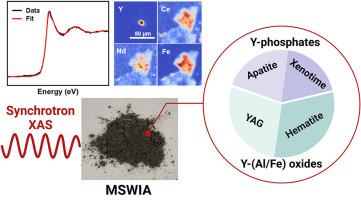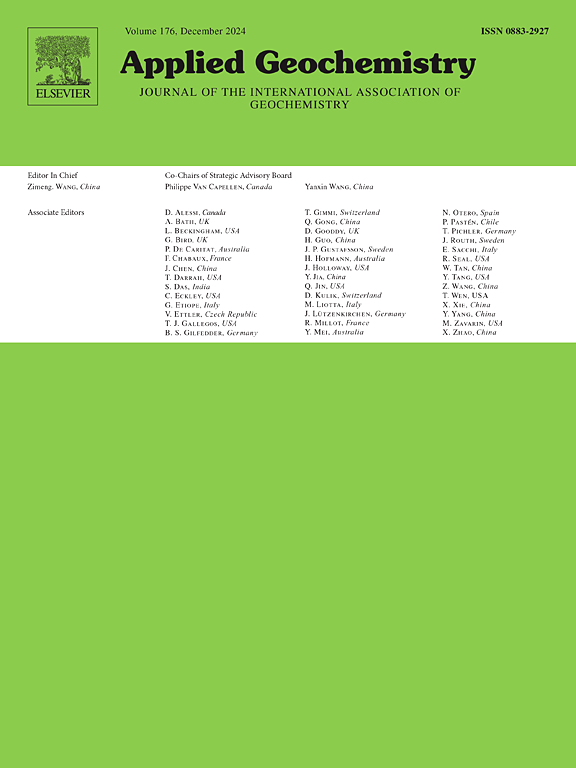Rare earth element (REE) speciation in municipal solid waste incineration ash
IF 3.1
3区 地球科学
Q1 GEOCHEMISTRY & GEOPHYSICS
引用次数: 0
Abstract
A robust and sustainable supply of rare earth elements (REE) is critically needed for clean-energy technologies, which has stimulated substantial interests in REE recovery from waste streams. Municipal solid waste incineration ash (MSWIA) was recently recognized as a potentially important REE resource, yet REE speciation in MSWIA remains poorly understood. This study employed synchrotron X-ray spectroscopy and microscopy techniques to elucidate the speciation of representative REE (Y, Ce, and Nd) in different MSWIA samples. Linear combination fitting of bulk X-ray absorption near edge structure (XANES) data indicated that Y-bearing Al/Fe oxides and phosphates are the primary Y-hosting phases. Micro-XANES of individual Y-containing particles identified by micro X-ray fluorescence (μXRF) mapping revealed notably different Y speciation at micro-scale from the bulk, consistent with the highly heterogeneous nature of MSWIA samples. The main REE-bearing phases in different size-fractionated MSWIA are similar: Y and Nd as oxides and xenotime/monazite, and Ce as apatite and monazite. Our results provide important insights for designing pre-screening processes (e.g., density separation) and optimizing extraction methods (e.g., pH, use of ligands) for cost-effective REE recovery from MSWIA.

城市生活垃圾焚烧灰中稀土元素(REE)形态分析
清洁能源技术迫切需要强劲和可持续的稀土元素供应,这激发了人们对从废物流中回收稀土元素的巨大兴趣。城市生活垃圾焚烧灰(MSWIA)最近被认为是一种潜在的重要稀土资源,但MSWIA中的稀土元素形态仍然知之甚少。本研究采用同步x射线光谱学和显微技术来阐明不同MSWIA样品中具有代表性的稀土元素(Y, Ce和Nd)的形态。体x射线吸收近边结构(XANES)数据的线性组合拟合表明,含y的Al/Fe氧化物和磷酸盐是主要的含y相。通过微x射线荧光(μXRF)定位鉴定的单个含Y颗粒的微xanes显示,在微观尺度上,Y的形态与体积明显不同,这与MSWIA样品的高度异质性一致。不同粒度分选MSWIA的主要含稀土相相似:Y和Nd为氧化物和xenotime/monazite, Ce为磷灰石和monazite。我们的研究结果为设计预筛选过程(如密度分离)和优化提取方法(如pH值,配体的使用)提供了重要的见解,从而具有成本效益地从MSWIA中回收稀土元素。
本文章由计算机程序翻译,如有差异,请以英文原文为准。
求助全文
约1分钟内获得全文
求助全文
来源期刊

Applied Geochemistry
地学-地球化学与地球物理
CiteScore
6.10
自引率
8.80%
发文量
272
审稿时长
65 days
期刊介绍:
Applied Geochemistry is an international journal devoted to publication of original research papers, rapid research communications and selected review papers in geochemistry and urban geochemistry which have some practical application to an aspect of human endeavour, such as the preservation of the environment, health, waste disposal and the search for resources. Papers on applications of inorganic, organic and isotope geochemistry and geochemical processes are therefore welcome provided they meet the main criterion. Spatial and temporal monitoring case studies are only of interest to our international readership if they present new ideas of broad application.
Topics covered include: (1) Environmental geochemistry (including natural and anthropogenic aspects, and protection and remediation strategies); (2) Hydrogeochemistry (surface and groundwater); (3) Medical (urban) geochemistry; (4) The search for energy resources (in particular unconventional oil and gas or emerging metal resources); (5) Energy exploitation (in particular geothermal energy and CCS); (6) Upgrading of energy and mineral resources where there is a direct geochemical application; and (7) Waste disposal, including nuclear waste disposal.
 求助内容:
求助内容: 应助结果提醒方式:
应助结果提醒方式:


